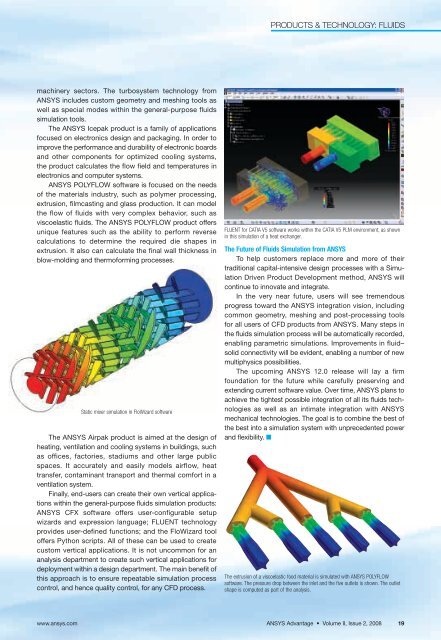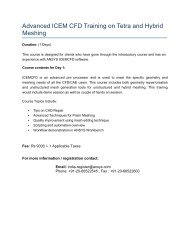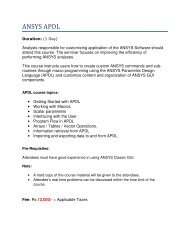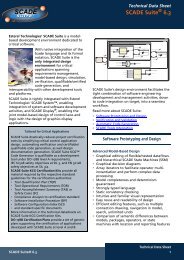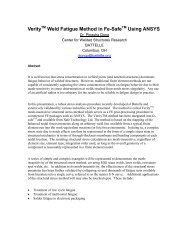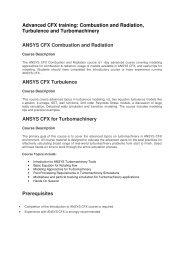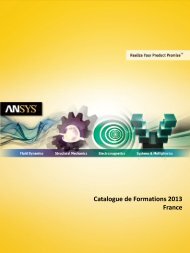Simulation - ANSYS
Simulation - ANSYS
Simulation - ANSYS
You also want an ePaper? Increase the reach of your titles
YUMPU automatically turns print PDFs into web optimized ePapers that Google loves.
machinery sectors. The turbosystem technology from<br />
<strong>ANSYS</strong> includes custom geometry and meshing tools as<br />
well as special modes within the general-purpose fluids<br />
simulation tools.<br />
The <strong>ANSYS</strong> Icepak product is a family of applications<br />
focused on electronics design and packaging. In order to<br />
improve the performance and durability of electronic boards<br />
and other components for optimized cooling systems,<br />
the product calculates the flow field and temperatures in<br />
electronics and computer systems.<br />
<strong>ANSYS</strong> POLYFLOW software is focused on the needs<br />
of the materials industry, such as polymer processing,<br />
extrusion, filmcasting and glass production. It can model<br />
the flow of fluids with very complex behavior, such as<br />
viscoelastic fluids. The <strong>ANSYS</strong> POLYFLOW product offers<br />
unique features such as the ability to perform reverse<br />
calculations to determine the required die shapes in<br />
extrusion. It also can calculate the final wall thickness in<br />
blow-molding and thermoforming processes.<br />
Static mixer simulation in FloWizard software<br />
The <strong>ANSYS</strong> Airpak product is aimed at the design of<br />
heating, ventilation and cooling systems in buildings, such<br />
as offices, factories, stadiums and other large public<br />
spaces. It accurately and easily models airflow, heat<br />
transfer, contaminant transport and thermal comfort in a<br />
ventilation system.<br />
Finally, end-users can create their own vertical applications<br />
within the general-purpose fluids simulation products:<br />
<strong>ANSYS</strong> CFX software offers user-configurable setup<br />
wizards and expression language; FLUENT technology<br />
provides user-defined functions; and the FloWizard tool<br />
offers Python scripts. All of these can be used to create<br />
custom vertical applications. It is not uncommon for an<br />
analysis department to create such vertical applications for<br />
deployment within a design department. The main benefit of<br />
this approach is to ensure repeatable simulation process<br />
control, and hence quality control, for any CFD process.<br />
PRODUCTS & TECHNOLOGY: FLUIDS<br />
FLUENT for CATIA V5 software works within the CATIA V5 PLM environment, as shown<br />
in this simulation of a heat exchanger.<br />
The Future of Fluids <strong>Simulation</strong> from <strong>ANSYS</strong><br />
To help customers replace more and more of their<br />
traditional capital-intensive design processes with a <strong>Simulation</strong><br />
Driven Product Development method, <strong>ANSYS</strong> will<br />
continue to innovate and integrate.<br />
In the very near future, users will see tremendous<br />
progress toward the <strong>ANSYS</strong> integration vision, including<br />
common geometry, meshing and post-processing tools<br />
for all users of CFD products from <strong>ANSYS</strong>. Many steps in<br />
the fluids simulation process will be automatically recorded,<br />
enabling parametric simulations. Improvements in fluid–<br />
solid connectivity will be evident, enabling a number of new<br />
multiphysics possibilities.<br />
The upcoming <strong>ANSYS</strong> 12.0 release will lay a firm<br />
foundation for the future while carefully preserving and<br />
extending current software value. Over time, <strong>ANSYS</strong> plans to<br />
achieve the tightest possible integration of all its fluids technologies<br />
as well as an intimate integration with <strong>ANSYS</strong><br />
mechanical technologies. The goal is to combine the best of<br />
the best into a simulation system with unprecedented power<br />
and flexibility. ■<br />
The extrusion of a viscoelastic food material is simulated with <strong>ANSYS</strong> POLYFLOW<br />
software. The pressure drop between the inlet and the five outlets is shown. The outlet<br />
shape is computed as part of the analysis.<br />
www.ansys.com <strong>ANSYS</strong> Advantage • Volume II, Issue 2, 2008 19


